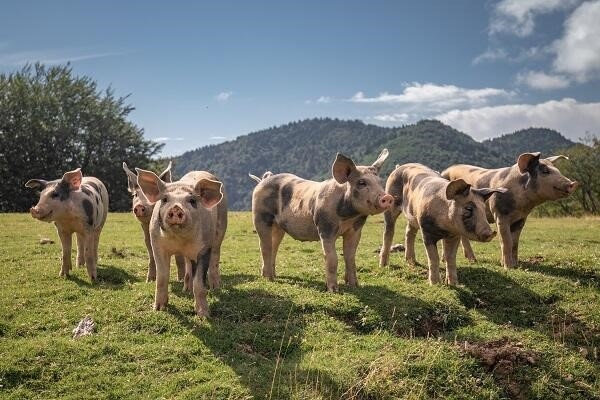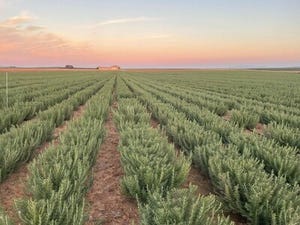Tabletop exercise focuses on ASF response in U.S.
Exercise at Plum Island Animal Disease Center centered on laboratory response preparedness.

The African swine fever (ASF) outbreak that has been ravaging China since August 2018 and spreading to other Asian countries presents a considerable threat to a nation’s economy through the loss of its agricultural resources, according to a "Snapshot" announcement from the U.S. Department of Homeland Security's (DHS) Science & Technology Directorate (S&T). Such an impact is currently being felt in China, Mongolia, Vietnam, Japan, North Korea and, most recently, South Korea, S&T said, and this infectious disease is affecting not only pig farmers but also farmers growing crops to feed the pig herds.
The ASF virus infects domesticated and wild pigs, but it does not infect humans. As it multiplies, the virus causes internal bleeding and results in almost 100% mortality of infected pigs.
The U.S. pork industry produces $20 billion of meat annually, S&T said, pointing to recent estimates from the U.S. Department of Commerce. If this disease made its way to the U.S., the results could be devastating.
Last year, S&T intensified vaccine research efforts in collaboration with the U. S. Department of Agriculture by creating an ASF task force based out of the S&T Plum Island Animal Disease Center (PIADC) in New York. The task force’s primary focus is on developing a vaccine and improving the diagnostics for ASF.
“The emergence of African swine fever has decimated the swine industry in China, but the effects will likely be felt worldwide,” PIADC director Dr. Larry Barrett said. “No outbreaks have been reported in the U.S., but DHS, USDA and the entire National Animal Health Laboratory Network (NAHLN) need to be prepared to fend off this intractable contagion.”
To prepare the U.S. for a domestic outbreak of ASF, S&T and USDA’s Animal & Plant Health Inspection Service recently conducted a tabletop exercise at PIADC centered on laboratory response preparedness. The most important part of the exercise was to see how different government and scientific entities collaborated to solve a major national problem: an ASF outbreak that could negatively affect the U.S. food supply and the economy, S&T said.
Background
The exercise was part of a four-day ASF training and exercise program hosted by S&T and USDA's Foreign Animal Disease Diagnostic Laboratory (FADDL). Multiple federal, state and scientific institutions participated in the course, with representation from 32 states. The event consisted of an incident command system course designed for a hypothetical outbreak of ASF and focused on laboratory-centric objectives, a robust tabletop exercise and informative laboratory tours.
“Since FADDL is the vanguard of foreign animal disease protection, I thought it propitious for Plum Island to develop and host a multi-agency training and exercise event to bolster preparedness,” PIADC programs manager Kevin Reilly said. “This was a one-of-a-kind event that left its participants feeling decidedly more prepared.”
Tabletop exercise
The exercise simulated multi-agency response efforts for the first 60 days of an ASF outbreak in multiple states. S&T and USDA wanted to observe and assess how lab communications performed during animal disease outbreaks and determine the efficacy of diagnostic strategies and surge response procedures to such incidents, the announcement said.
This emergency response exercise consisted of three modules: "Initial Outbreak" (days 1-3), "Surge Response" (days 4-24) and "Ongoing Response" (days 25-60). Each module began with a multimedia summary of key events from that time period, and then the participants reviewed the situation and discussed the appropriate response tactics. The participants practiced notification and communication strategies, deploying and recalling surge support staff, exploiting resource capabilities, processing samples and prioritizing their efforts, S&T reported. Immediately after the exercise, participants discussed the strengths and weaknesses of the current incident response structure and lessons learned.
Potential impact
The event embodied the collaboration needed among federal, state and academic partners to effectively respond to a foreign animal disease introduction, the agency said.
“The emphasis of this particular exercise on the laboratory response was critical and, I think, a unique perspective for such a large-scale tabletop,” said Dr. Jamie Barnabei, veterinary medical officer for the North American Foot & Mouth Vaccine Bank.
During the event, diagnostic and response experts from various states engaged in a hypothetical — but realistic — outbreak scenario and had the opportunity to test the necessary response protocols.
“In the event of an African swine fever outbreak or other serious foreign animal disease outbreak in the continental U.S., the abilities of the NAHLN Laboratories and PIADC to work together to effectively and efficiently provide testing to identify where the outbreak is and provide proof of negative disease status to impacted producers would be critical to disease eradication and the continuity of business,” Dr. Leslie Cole, a USDA veterinarian and emergency coordinator, said. “This unique, interagency training provided decision-makers from these organizations the opportunity to learn how to implement a common operational framework and allowed them to practice how they would organize and respond.”
All of the agencies charged with animal disease outbreak preparedness have similar procedures and share common goals, but they seldom get to collaborate in person. This ASF training and exercise activity provided a unique opportunity for subject-matter experts to meet each other and compare notes.
“Members of 32 NAHLN laboratories participated in training, demonstration and response exercises that will strengthen the ability of the U.S. animal diagnostics laboratories to be successful in addressing an incursion of African swine fever to this country or any other diseases,” said veterinarian Dr. Christina M. Loiacono, USDA's NAHLN coordinator.
NPPC insight
Liz Wagstrom, chief veterinarian for the National Pork Producers Council (NPPC), said in the last year, there has been a tremendous amount of work to further the understanding of handling and preventing an outbreak of ASF.
Wagstrom explained that there’s a lot of work going on regarding safely moving animals. NPPC is telling producers to plan for a minimum lockdown on movement for 72-96 hours, or maybe even a week. Therefore, producers need to determine a contingency plan if that occurs.
Movement may also require permits, which then would require a big data system that allows state or federal veterinarians to write permits and also handle the information regarding where other outbreaks may be occurring. Wagstrom said the government exercise determined that there were gaps between how and what states were going to require to be permitted. Permits may also be required for movement of feed or semen.
Following the exercise, Wagstrom said a group of the 12 most hog-populated states will look at how to consistently handle these sorts of situations that would arise in the event of a positive case of ASF.
“One of the big things we’re working on is making sure that producers know and understand the secure pork supply and the enhanced biosecurity plans that are part of that,” Wagstrom added.
Part of the biosecurity plan includes establishing a perimeter, which ideally would be a fence, but at least should be a gate across the driveway. Another practice is to separate the drive for those trucks that are loading in and out versus trucks that might be from rendering or from separate locations.
About the Author(s)
You May Also Like





